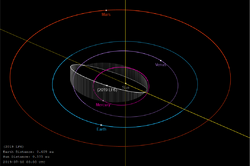Astronomy:2019 LF6
 Highly inclined orbit of 2019 LF6 passing within Mercury's orbit, and slightly outside Venus's orbit | |
| Discovery [1] | |
|---|---|
| Discovered by | Zwicky Transient Facility |
| Discovery site | Palomar Obs. |
| Discovery date | 10 June 2019 (first observed only) |
| Designations | |
| 2019 LF6 | |
| Minor planet category | NEO · Atira [1] |
| Orbital characteristics [2] | |
| Epoch 31 May 2020 (JD 2459000.5) | |
| Uncertainty parameter 3 | |
| Observation arc | 358 days |
| |{{{apsis}}}|helion}} | 0.7938 AU |
| |{{{apsis}}}|helion}} | 0.3170 AU |
| 0.5554 AU | |
| Eccentricity | 0.42928 |
| Orbital period | 0.41 yr (151.2 d) |
| Mean anomaly | 347.653° |
| Mean motion | 2° 22m 51.74s / day |
| Inclination | 29.506° |
| Longitude of ascending node | 179.029° |
| 213.779° | |
| Earth MOID | 0.2608 AU |
| Physical characteristics | |
| Mean diameter | 1–2 km (est. at 0.05–0.15) |
| Absolute magnitude (H) | 17.200±0.398[2] |
2019 LF6 is a near-Earth object of the Atira group. After 2021 PH27, it has the second-smallest semi-major axis among the known asteroids (0.555 AU), beating the previously-held record of 2019 AQ3.[3][4] It orbits the Sun in 151 days.[2]
Discovery
Discovered at only 19th magnitude, it is very difficult to see, never getting far from the sun and twilight.[5] It only occasionally brightens above 16th magnitude. Discovery was made using the Zwicky Transient Facility.[6]
Orbit and classification
It orbits the Sun at a distance of 0.3–0.8 AU once every 5 months (151 days; semi-major axis of 0.56 AU). Its orbit has an eccentricity of 0.43 and an unusually high[6] inclination of 30° with respect to the ecliptic.[2]
The asteroids 594913 ꞌAylóꞌchaxnim and 2019 AQ3 are the only known asteroids with closer aphelions. The orbital evolution of 2019 AQ3 is similar to that of 2019 LF6.[7]
References
- ↑ 1.0 1.1 "2019 LF6". Minor Planet Center. https://www.minorplanetcenter.net/db_search/show_object?object_id=2019+LF6. Retrieved 10 July 2019.
- ↑ 2.0 2.1 2.2 2.3 "JPL Small-Body Database Browser: (2019 LF6)". Jet Propulsion Laboratory. https://ssd.jpl.nasa.gov/sbdb.cgi?sstr=3842903. Retrieved 10 July 2019.
- ↑ "JPL Small-Body Database Search Engine: a > 0 (au) and a < 0.7 (au) and data-arc span > 3 (d)". JPL Solar System Dynamics. http://ssd.jpl.nasa.gov/sbdb_query.cgi?obj_group=all;obj_kind=all;obj_numbered=all;OBJ_field=0;ORB_field=0;combine_mode=AND;c1_group=ORB;c1_item=Bh;c1_op=%3E;c1_value=0;c2_group=ORB;c2_item=Bh;c2_op=%3C;c2_value=0.7;c3_group=ORB;c3_item=Ck;c3_op=%3E;c3_value=3;table_format=HTML;max_rows=100;format_option=comp;c_fields=AcBhBgBjBiBnBsCkCqAi;.cgifields=format_option;.cgifields=obj_kind;.cgifields=obj_group;.cgifields=obj_numbered;.cgifields=combine_mode;.cgifields=ast_orbit_class;.cgifields=table_format;.cgifields=com_orbit_class&query=1&c_sort=BhA. Retrieved 10 July 2019.
- ↑ de la Fuente Marcos, Carlos; de la Fuente Marcos, Raúl (1 August 2019). "Understanding the evolution of Atira-class asteroid 2019 AQ3, a major step towards the future discovery of the Vatira population". Monthly Notices of the Royal Astronomical Society 487 (2): 2742–2752. doi:10.1093/mnras/stz1437. Bibcode: 2019MNRAS.487.2742D. https://academic.oup.com/mnras/article-abstract/487/2/2742/5498309.
- ↑ Hop Aboard 2019 LF6, The Asteroid With The Shortest Year Known Astrobob, 7/10/2019
- ↑ 6.0 6.1 Young, Monica (2019-07-10). "Sky-surveying Telescopes Sweep Up Near-Earth Asteroids" (in en-US). https://www.skyandtelescope.com/astronomy-news/telescopes-sweep-up-near-earth-asteroids/.
- ↑ de la Fuente Marcos, Carlos; de la Fuente Marcos, Raúl (25 July 2019). "Hot and Eccentric: The Discovery of 2019 LF6 as a New Step in the Quest for the Vatira Population". Research Notes of the American Astronomical Society 3 (7): 106. doi:10.3847/2515-5172/ab346c. Bibcode: 2019RNAAS...3g.106D.
External links
- 2019 LF6 at NeoDyS-2, Near Earth Objects—Dynamic Site
- Ephemeris · Obs prediction · Orbital info · MOID · Proper elements · Obs info · Close · Physical info · NEOCC
- 2019 LF6 at the JPL Small-Body Database
 |

